Commonwealth Bank: Innovation, Smart Products & Business Development
VerifiedAdded on 2023/06/13
|9
|2348
|283
Essay
AI Summary
This essay analyzes the impact of innovation and smart connected products on Commonwealth Bank Australia's existing business model. It examines opportunities and threats arising from these developments, focusing on the business model as a value proposition and a set of capabilities and resources. The analysis includes a business model canvas, highlighting key partners, activities, value propositions, customer relationships, segments, resources, channels, cost structure, and revenue streams. The essay concludes that innovation is crucial for Commonwealth Bank to compete effectively and maintain a stable future, emphasizing the importance of adapting the business model to incorporate new technologies while ensuring customer satisfaction and operational efficiency. Desklib provides a platform to access this and similar solved assignments.
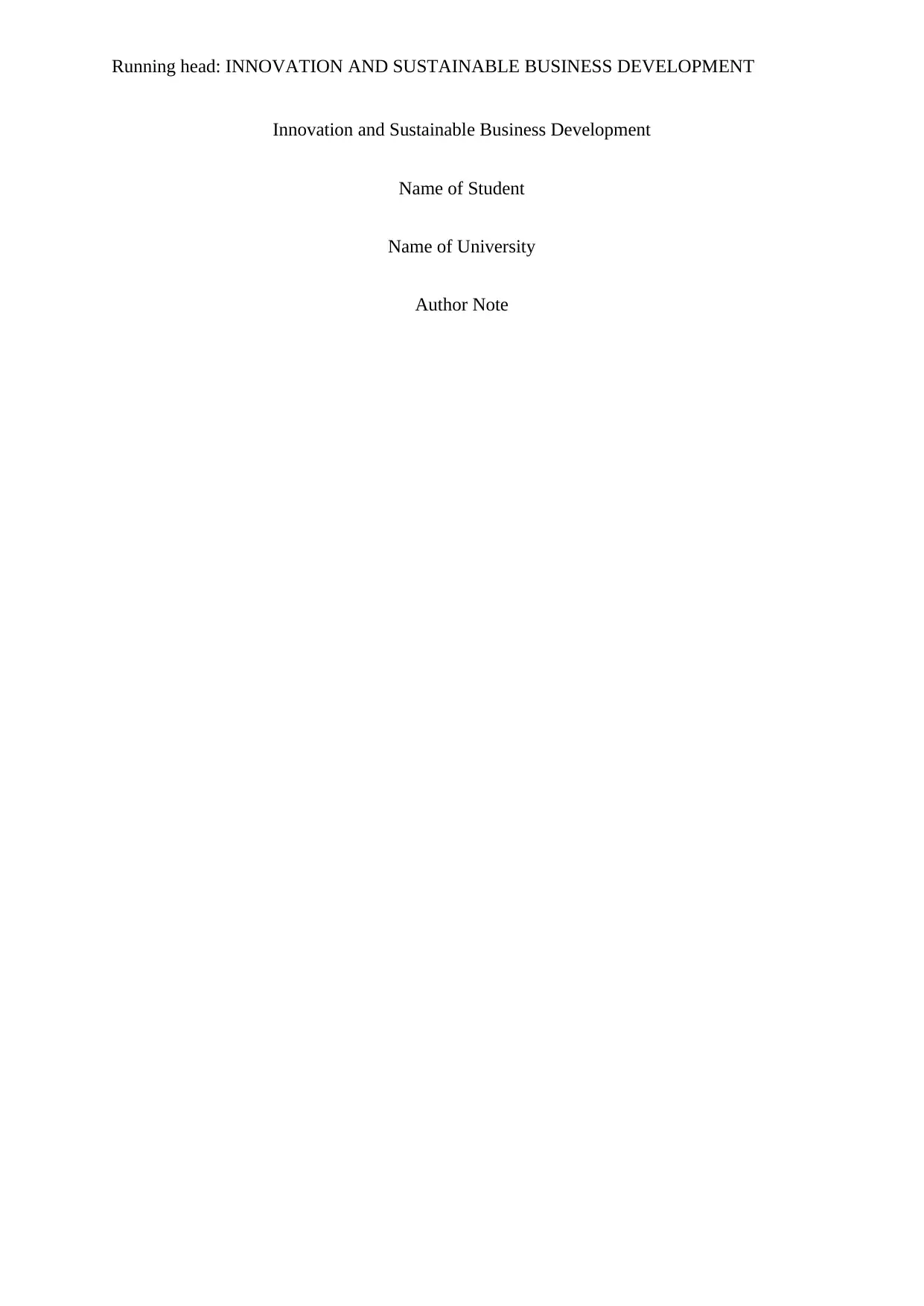
Running head: INNOVATION AND SUSTAINABLE BUSINESS DEVELOPMENT
Innovation and Sustainable Business Development
Name of Student
Name of University
Author Note
Innovation and Sustainable Business Development
Name of Student
Name of University
Author Note
Paraphrase This Document
Need a fresh take? Get an instant paraphrase of this document with our AI Paraphraser
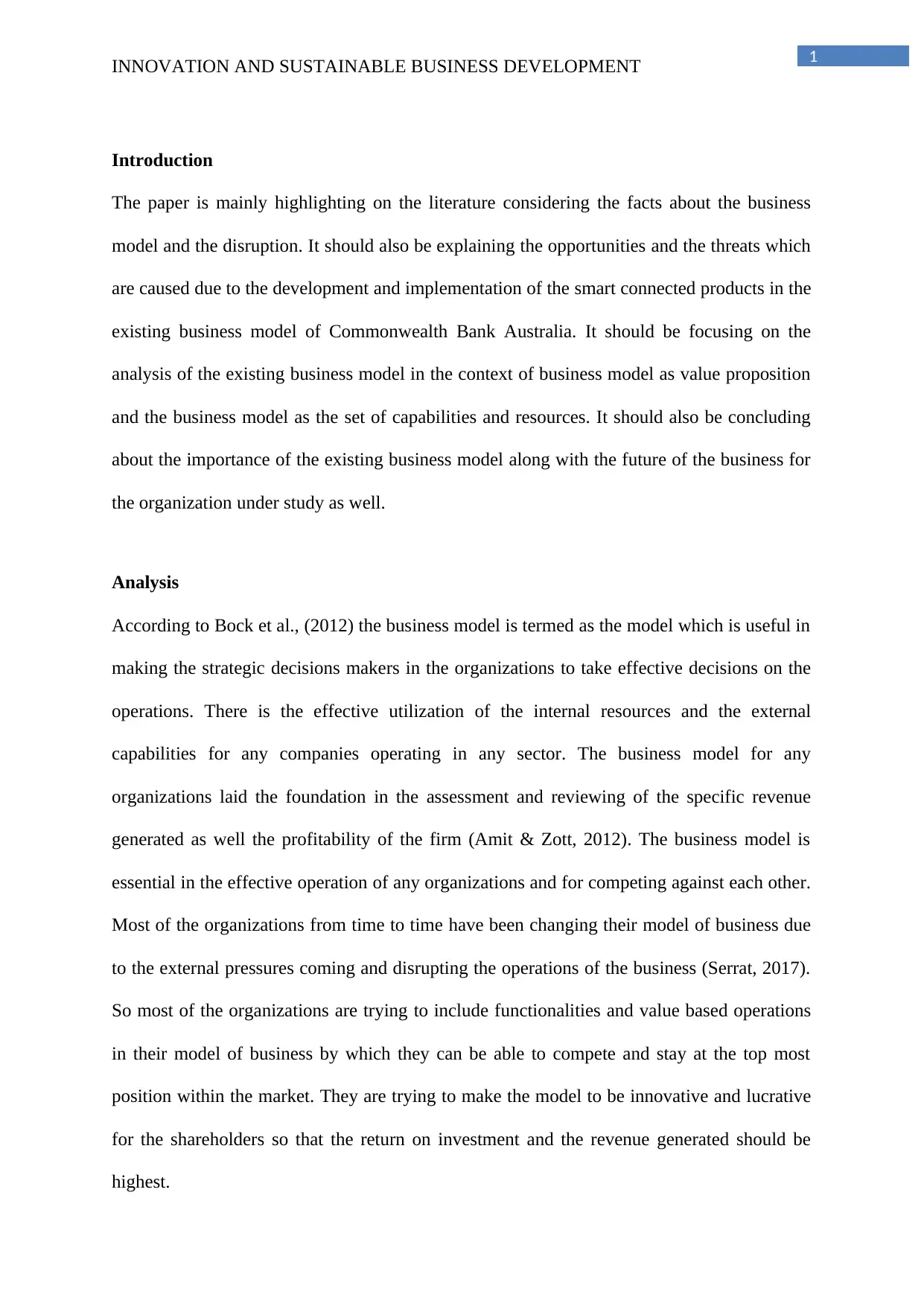
1
INNOVATION AND SUSTAINABLE BUSINESS DEVELOPMENT
Introduction
The paper is mainly highlighting on the literature considering the facts about the business
model and the disruption. It should also be explaining the opportunities and the threats which
are caused due to the development and implementation of the smart connected products in the
existing business model of Commonwealth Bank Australia. It should be focusing on the
analysis of the existing business model in the context of business model as value proposition
and the business model as the set of capabilities and resources. It should also be concluding
about the importance of the existing business model along with the future of the business for
the organization under study as well.
Analysis
According to Bock et al., (2012) the business model is termed as the model which is useful in
making the strategic decisions makers in the organizations to take effective decisions on the
operations. There is the effective utilization of the internal resources and the external
capabilities for any companies operating in any sector. The business model for any
organizations laid the foundation in the assessment and reviewing of the specific revenue
generated as well the profitability of the firm (Amit & Zott, 2012). The business model is
essential in the effective operation of any organizations and for competing against each other.
Most of the organizations from time to time have been changing their model of business due
to the external pressures coming and disrupting the operations of the business (Serrat, 2017).
So most of the organizations are trying to include functionalities and value based operations
in their model of business by which they can be able to compete and stay at the top most
position within the market. They are trying to make the model to be innovative and lucrative
for the shareholders so that the return on investment and the revenue generated should be
highest.
INNOVATION AND SUSTAINABLE BUSINESS DEVELOPMENT
Introduction
The paper is mainly highlighting on the literature considering the facts about the business
model and the disruption. It should also be explaining the opportunities and the threats which
are caused due to the development and implementation of the smart connected products in the
existing business model of Commonwealth Bank Australia. It should be focusing on the
analysis of the existing business model in the context of business model as value proposition
and the business model as the set of capabilities and resources. It should also be concluding
about the importance of the existing business model along with the future of the business for
the organization under study as well.
Analysis
According to Bock et al., (2012) the business model is termed as the model which is useful in
making the strategic decisions makers in the organizations to take effective decisions on the
operations. There is the effective utilization of the internal resources and the external
capabilities for any companies operating in any sector. The business model for any
organizations laid the foundation in the assessment and reviewing of the specific revenue
generated as well the profitability of the firm (Amit & Zott, 2012). The business model is
essential in the effective operation of any organizations and for competing against each other.
Most of the organizations from time to time have been changing their model of business due
to the external pressures coming and disrupting the operations of the business (Serrat, 2017).
So most of the organizations are trying to include functionalities and value based operations
in their model of business by which they can be able to compete and stay at the top most
position within the market. They are trying to make the model to be innovative and lucrative
for the shareholders so that the return on investment and the revenue generated should be
highest.
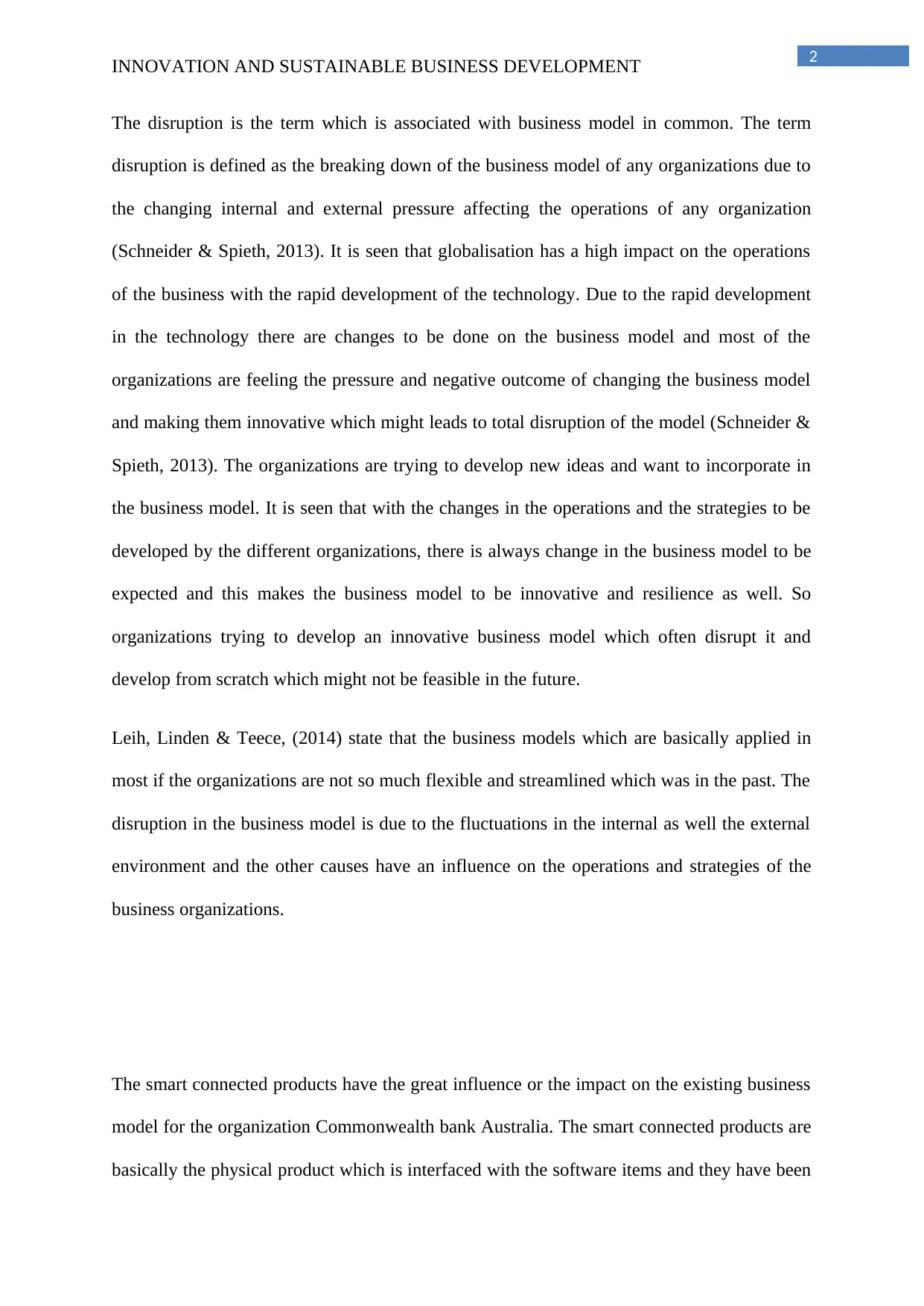
2
INNOVATION AND SUSTAINABLE BUSINESS DEVELOPMENT
The disruption is the term which is associated with business model in common. The term
disruption is defined as the breaking down of the business model of any organizations due to
the changing internal and external pressure affecting the operations of any organization
(Schneider & Spieth, 2013). It is seen that globalisation has a high impact on the operations
of the business with the rapid development of the technology. Due to the rapid development
in the technology there are changes to be done on the business model and most of the
organizations are feeling the pressure and negative outcome of changing the business model
and making them innovative which might leads to total disruption of the model (Schneider &
Spieth, 2013). The organizations are trying to develop new ideas and want to incorporate in
the business model. It is seen that with the changes in the operations and the strategies to be
developed by the different organizations, there is always change in the business model to be
expected and this makes the business model to be innovative and resilience as well. So
organizations trying to develop an innovative business model which often disrupt it and
develop from scratch which might not be feasible in the future.
Leih, Linden & Teece, (2014) state that the business models which are basically applied in
most if the organizations are not so much flexible and streamlined which was in the past. The
disruption in the business model is due to the fluctuations in the internal as well the external
environment and the other causes have an influence on the operations and strategies of the
business organizations.
The smart connected products have the great influence or the impact on the existing business
model for the organization Commonwealth bank Australia. The smart connected products are
basically the physical product which is interfaced with the software items and they have been
INNOVATION AND SUSTAINABLE BUSINESS DEVELOPMENT
The disruption is the term which is associated with business model in common. The term
disruption is defined as the breaking down of the business model of any organizations due to
the changing internal and external pressure affecting the operations of any organization
(Schneider & Spieth, 2013). It is seen that globalisation has a high impact on the operations
of the business with the rapid development of the technology. Due to the rapid development
in the technology there are changes to be done on the business model and most of the
organizations are feeling the pressure and negative outcome of changing the business model
and making them innovative which might leads to total disruption of the model (Schneider &
Spieth, 2013). The organizations are trying to develop new ideas and want to incorporate in
the business model. It is seen that with the changes in the operations and the strategies to be
developed by the different organizations, there is always change in the business model to be
expected and this makes the business model to be innovative and resilience as well. So
organizations trying to develop an innovative business model which often disrupt it and
develop from scratch which might not be feasible in the future.
Leih, Linden & Teece, (2014) state that the business models which are basically applied in
most if the organizations are not so much flexible and streamlined which was in the past. The
disruption in the business model is due to the fluctuations in the internal as well the external
environment and the other causes have an influence on the operations and strategies of the
business organizations.
The smart connected products have the great influence or the impact on the existing business
model for the organization Commonwealth bank Australia. The smart connected products are
basically the physical product which is interfaced with the software items and they have been
⊘ This is a preview!⊘
Do you want full access?
Subscribe today to unlock all pages.

Trusted by 1+ million students worldwide
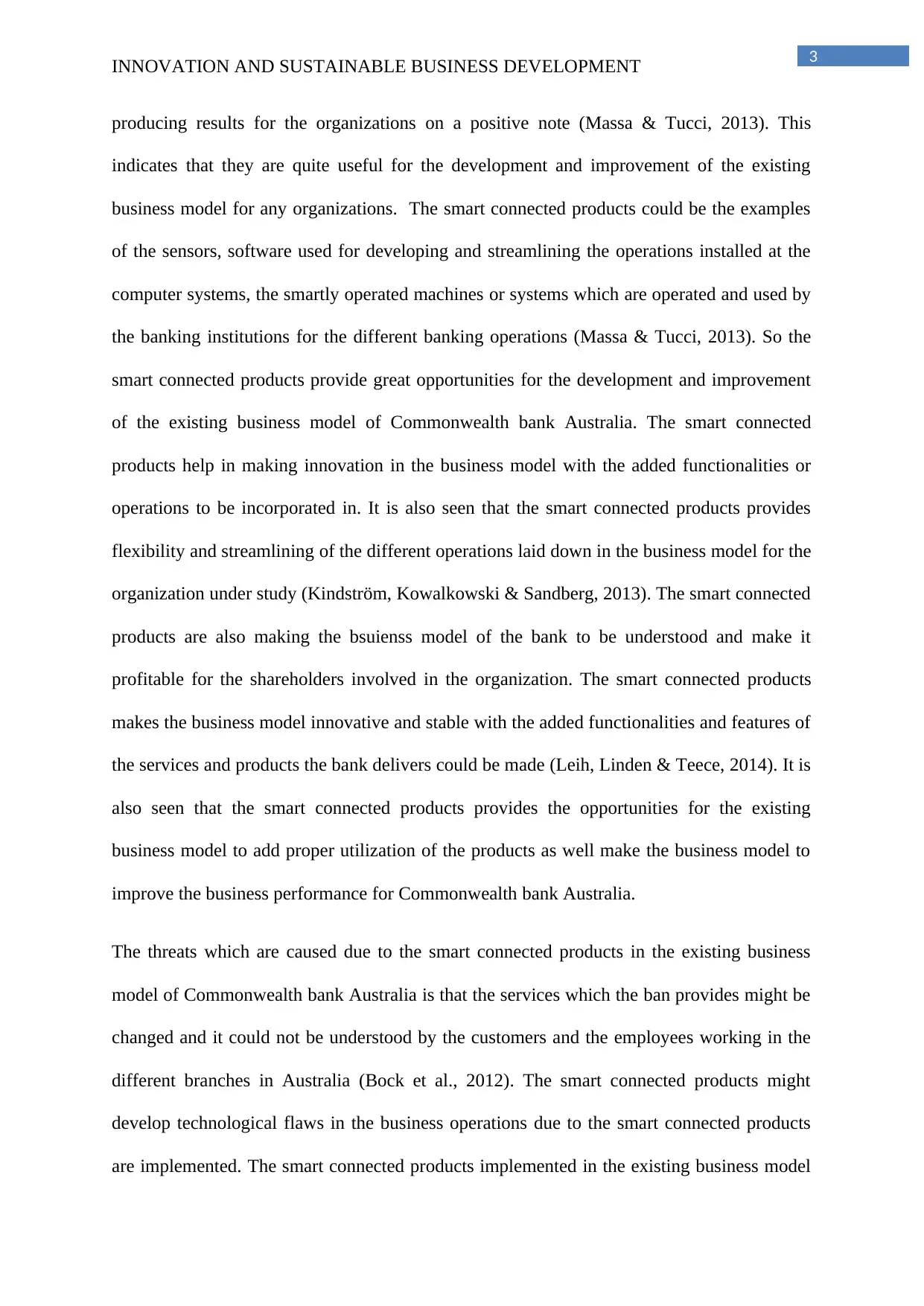
3
INNOVATION AND SUSTAINABLE BUSINESS DEVELOPMENT
producing results for the organizations on a positive note (Massa & Tucci, 2013). This
indicates that they are quite useful for the development and improvement of the existing
business model for any organizations. The smart connected products could be the examples
of the sensors, software used for developing and streamlining the operations installed at the
computer systems, the smartly operated machines or systems which are operated and used by
the banking institutions for the different banking operations (Massa & Tucci, 2013). So the
smart connected products provide great opportunities for the development and improvement
of the existing business model of Commonwealth bank Australia. The smart connected
products help in making innovation in the business model with the added functionalities or
operations to be incorporated in. It is also seen that the smart connected products provides
flexibility and streamlining of the different operations laid down in the business model for the
organization under study (Kindström, Kowalkowski & Sandberg, 2013). The smart connected
products are also making the bsuienss model of the bank to be understood and make it
profitable for the shareholders involved in the organization. The smart connected products
makes the business model innovative and stable with the added functionalities and features of
the services and products the bank delivers could be made (Leih, Linden & Teece, 2014). It is
also seen that the smart connected products provides the opportunities for the existing
business model to add proper utilization of the products as well make the business model to
improve the business performance for Commonwealth bank Australia.
The threats which are caused due to the smart connected products in the existing business
model of Commonwealth bank Australia is that the services which the ban provides might be
changed and it could not be understood by the customers and the employees working in the
different branches in Australia (Bock et al., 2012). The smart connected products might
develop technological flaws in the business operations due to the smart connected products
are implemented. The smart connected products implemented in the existing business model
INNOVATION AND SUSTAINABLE BUSINESS DEVELOPMENT
producing results for the organizations on a positive note (Massa & Tucci, 2013). This
indicates that they are quite useful for the development and improvement of the existing
business model for any organizations. The smart connected products could be the examples
of the sensors, software used for developing and streamlining the operations installed at the
computer systems, the smartly operated machines or systems which are operated and used by
the banking institutions for the different banking operations (Massa & Tucci, 2013). So the
smart connected products provide great opportunities for the development and improvement
of the existing business model of Commonwealth bank Australia. The smart connected
products help in making innovation in the business model with the added functionalities or
operations to be incorporated in. It is also seen that the smart connected products provides
flexibility and streamlining of the different operations laid down in the business model for the
organization under study (Kindström, Kowalkowski & Sandberg, 2013). The smart connected
products are also making the bsuienss model of the bank to be understood and make it
profitable for the shareholders involved in the organization. The smart connected products
makes the business model innovative and stable with the added functionalities and features of
the services and products the bank delivers could be made (Leih, Linden & Teece, 2014). It is
also seen that the smart connected products provides the opportunities for the existing
business model to add proper utilization of the products as well make the business model to
improve the business performance for Commonwealth bank Australia.
The threats which are caused due to the smart connected products in the existing business
model of Commonwealth bank Australia is that the services which the ban provides might be
changed and it could not be understood by the customers and the employees working in the
different branches in Australia (Bock et al., 2012). The smart connected products might
develop technological flaws in the business operations due to the smart connected products
are implemented. The smart connected products implemented in the existing business model
Paraphrase This Document
Need a fresh take? Get an instant paraphrase of this document with our AI Paraphraser
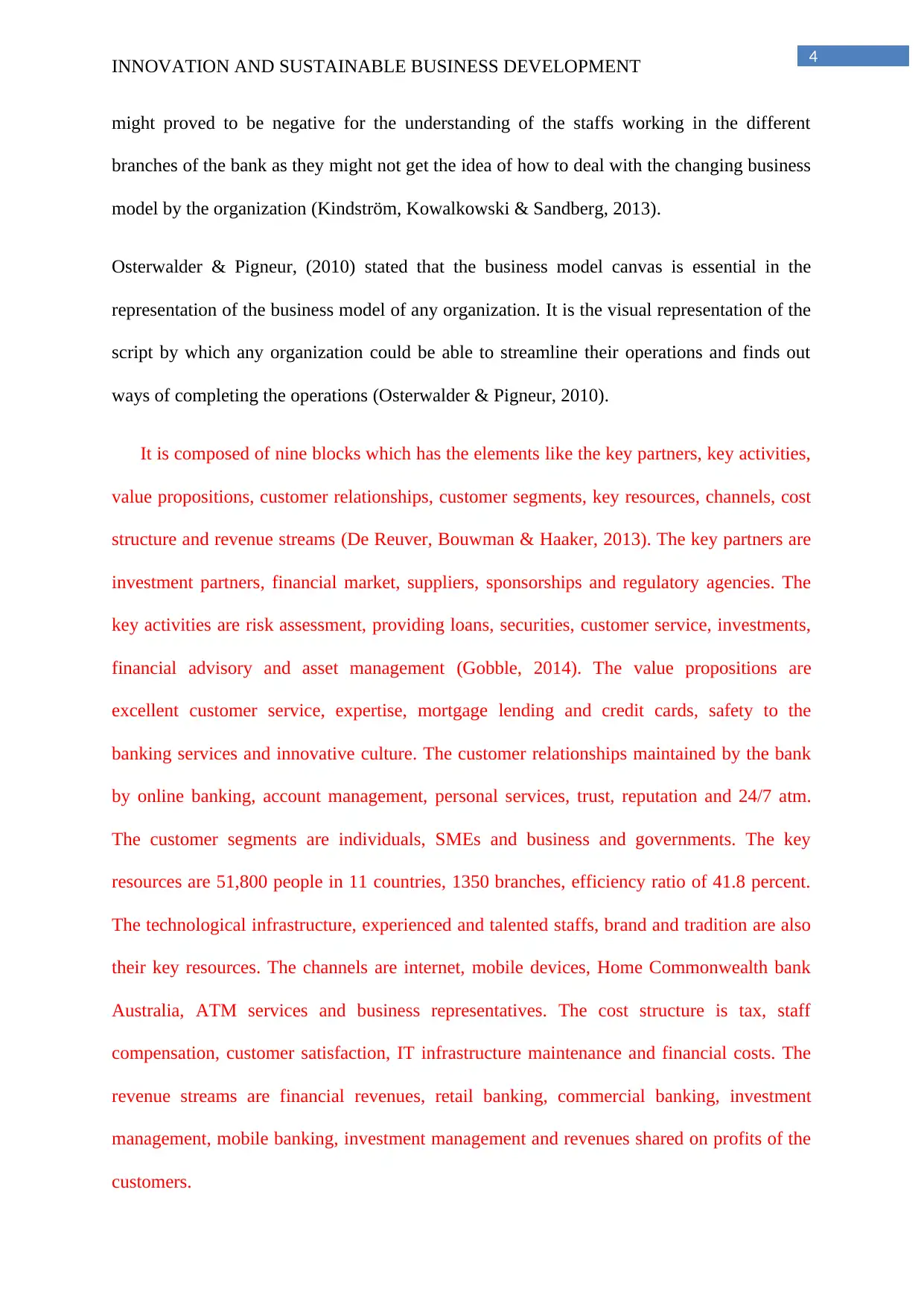
4
INNOVATION AND SUSTAINABLE BUSINESS DEVELOPMENT
might proved to be negative for the understanding of the staffs working in the different
branches of the bank as they might not get the idea of how to deal with the changing business
model by the organization (Kindström, Kowalkowski & Sandberg, 2013).
Osterwalder & Pigneur, (2010) stated that the business model canvas is essential in the
representation of the business model of any organization. It is the visual representation of the
script by which any organization could be able to streamline their operations and finds out
ways of completing the operations (Osterwalder & Pigneur, 2010).
It is composed of nine blocks which has the elements like the key partners, key activities,
value propositions, customer relationships, customer segments, key resources, channels, cost
structure and revenue streams (De Reuver, Bouwman & Haaker, 2013). The key partners are
investment partners, financial market, suppliers, sponsorships and regulatory agencies. The
key activities are risk assessment, providing loans, securities, customer service, investments,
financial advisory and asset management (Gobble, 2014). The value propositions are
excellent customer service, expertise, mortgage lending and credit cards, safety to the
banking services and innovative culture. The customer relationships maintained by the bank
by online banking, account management, personal services, trust, reputation and 24/7 atm.
The customer segments are individuals, SMEs and business and governments. The key
resources are 51,800 people in 11 countries, 1350 branches, efficiency ratio of 41.8 percent.
The technological infrastructure, experienced and talented staffs, brand and tradition are also
their key resources. The channels are internet, mobile devices, Home Commonwealth bank
Australia, ATM services and business representatives. The cost structure is tax, staff
compensation, customer satisfaction, IT infrastructure maintenance and financial costs. The
revenue streams are financial revenues, retail banking, commercial banking, investment
management, mobile banking, investment management and revenues shared on profits of the
customers.
INNOVATION AND SUSTAINABLE BUSINESS DEVELOPMENT
might proved to be negative for the understanding of the staffs working in the different
branches of the bank as they might not get the idea of how to deal with the changing business
model by the organization (Kindström, Kowalkowski & Sandberg, 2013).
Osterwalder & Pigneur, (2010) stated that the business model canvas is essential in the
representation of the business model of any organization. It is the visual representation of the
script by which any organization could be able to streamline their operations and finds out
ways of completing the operations (Osterwalder & Pigneur, 2010).
It is composed of nine blocks which has the elements like the key partners, key activities,
value propositions, customer relationships, customer segments, key resources, channels, cost
structure and revenue streams (De Reuver, Bouwman & Haaker, 2013). The key partners are
investment partners, financial market, suppliers, sponsorships and regulatory agencies. The
key activities are risk assessment, providing loans, securities, customer service, investments,
financial advisory and asset management (Gobble, 2014). The value propositions are
excellent customer service, expertise, mortgage lending and credit cards, safety to the
banking services and innovative culture. The customer relationships maintained by the bank
by online banking, account management, personal services, trust, reputation and 24/7 atm.
The customer segments are individuals, SMEs and business and governments. The key
resources are 51,800 people in 11 countries, 1350 branches, efficiency ratio of 41.8 percent.
The technological infrastructure, experienced and talented staffs, brand and tradition are also
their key resources. The channels are internet, mobile devices, Home Commonwealth bank
Australia, ATM services and business representatives. The cost structure is tax, staff
compensation, customer satisfaction, IT infrastructure maintenance and financial costs. The
revenue streams are financial revenues, retail banking, commercial banking, investment
management, mobile banking, investment management and revenues shared on profits of the
customers.
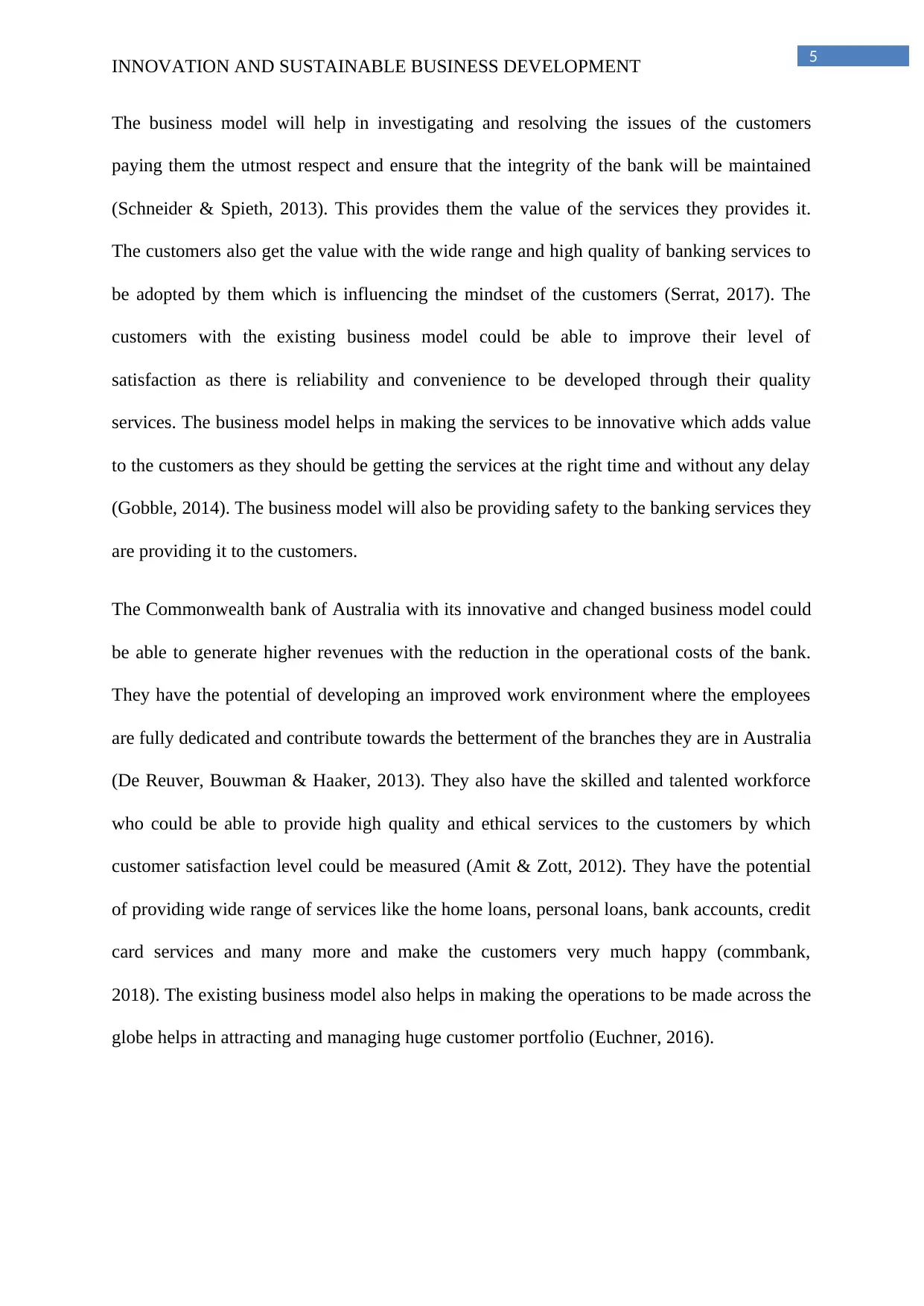
5
INNOVATION AND SUSTAINABLE BUSINESS DEVELOPMENT
The business model will help in investigating and resolving the issues of the customers
paying them the utmost respect and ensure that the integrity of the bank will be maintained
(Schneider & Spieth, 2013). This provides them the value of the services they provides it.
The customers also get the value with the wide range and high quality of banking services to
be adopted by them which is influencing the mindset of the customers (Serrat, 2017). The
customers with the existing business model could be able to improve their level of
satisfaction as there is reliability and convenience to be developed through their quality
services. The business model helps in making the services to be innovative which adds value
to the customers as they should be getting the services at the right time and without any delay
(Gobble, 2014). The business model will also be providing safety to the banking services they
are providing it to the customers.
The Commonwealth bank of Australia with its innovative and changed business model could
be able to generate higher revenues with the reduction in the operational costs of the bank.
They have the potential of developing an improved work environment where the employees
are fully dedicated and contribute towards the betterment of the branches they are in Australia
(De Reuver, Bouwman & Haaker, 2013). They also have the skilled and talented workforce
who could be able to provide high quality and ethical services to the customers by which
customer satisfaction level could be measured (Amit & Zott, 2012). They have the potential
of providing wide range of services like the home loans, personal loans, bank accounts, credit
card services and many more and make the customers very much happy (commbank,
2018). The existing business model also helps in making the operations to be made across the
globe helps in attracting and managing huge customer portfolio (Euchner, 2016).
INNOVATION AND SUSTAINABLE BUSINESS DEVELOPMENT
The business model will help in investigating and resolving the issues of the customers
paying them the utmost respect and ensure that the integrity of the bank will be maintained
(Schneider & Spieth, 2013). This provides them the value of the services they provides it.
The customers also get the value with the wide range and high quality of banking services to
be adopted by them which is influencing the mindset of the customers (Serrat, 2017). The
customers with the existing business model could be able to improve their level of
satisfaction as there is reliability and convenience to be developed through their quality
services. The business model helps in making the services to be innovative which adds value
to the customers as they should be getting the services at the right time and without any delay
(Gobble, 2014). The business model will also be providing safety to the banking services they
are providing it to the customers.
The Commonwealth bank of Australia with its innovative and changed business model could
be able to generate higher revenues with the reduction in the operational costs of the bank.
They have the potential of developing an improved work environment where the employees
are fully dedicated and contribute towards the betterment of the branches they are in Australia
(De Reuver, Bouwman & Haaker, 2013). They also have the skilled and talented workforce
who could be able to provide high quality and ethical services to the customers by which
customer satisfaction level could be measured (Amit & Zott, 2012). They have the potential
of providing wide range of services like the home loans, personal loans, bank accounts, credit
card services and many more and make the customers very much happy (commbank,
2018). The existing business model also helps in making the operations to be made across the
globe helps in attracting and managing huge customer portfolio (Euchner, 2016).
⊘ This is a preview!⊘
Do you want full access?
Subscribe today to unlock all pages.

Trusted by 1+ million students worldwide
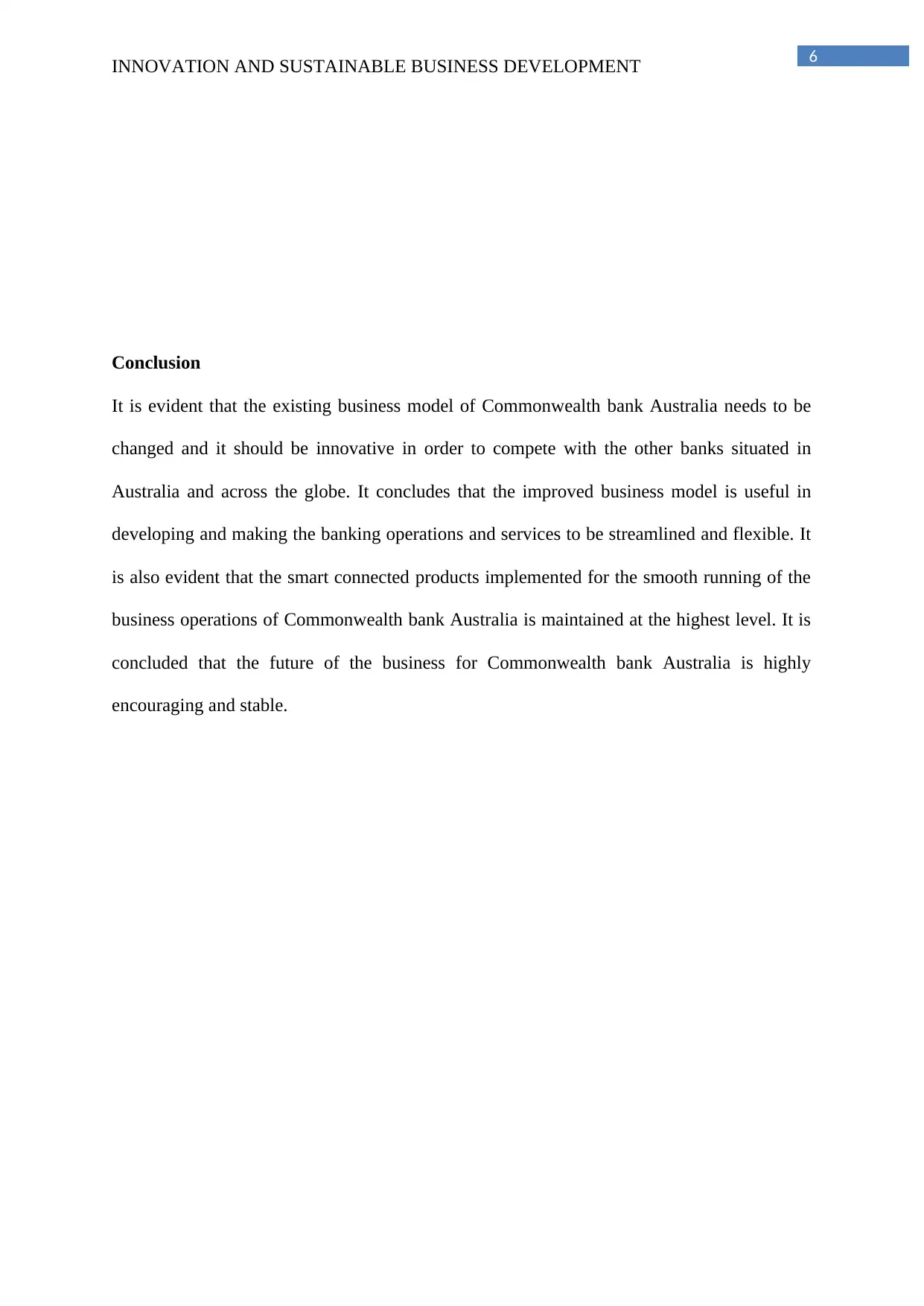
6
INNOVATION AND SUSTAINABLE BUSINESS DEVELOPMENT
Conclusion
It is evident that the existing business model of Commonwealth bank Australia needs to be
changed and it should be innovative in order to compete with the other banks situated in
Australia and across the globe. It concludes that the improved business model is useful in
developing and making the banking operations and services to be streamlined and flexible. It
is also evident that the smart connected products implemented for the smooth running of the
business operations of Commonwealth bank Australia is maintained at the highest level. It is
concluded that the future of the business for Commonwealth bank Australia is highly
encouraging and stable.
INNOVATION AND SUSTAINABLE BUSINESS DEVELOPMENT
Conclusion
It is evident that the existing business model of Commonwealth bank Australia needs to be
changed and it should be innovative in order to compete with the other banks situated in
Australia and across the globe. It concludes that the improved business model is useful in
developing and making the banking operations and services to be streamlined and flexible. It
is also evident that the smart connected products implemented for the smooth running of the
business operations of Commonwealth bank Australia is maintained at the highest level. It is
concluded that the future of the business for Commonwealth bank Australia is highly
encouraging and stable.
Paraphrase This Document
Need a fresh take? Get an instant paraphrase of this document with our AI Paraphraser
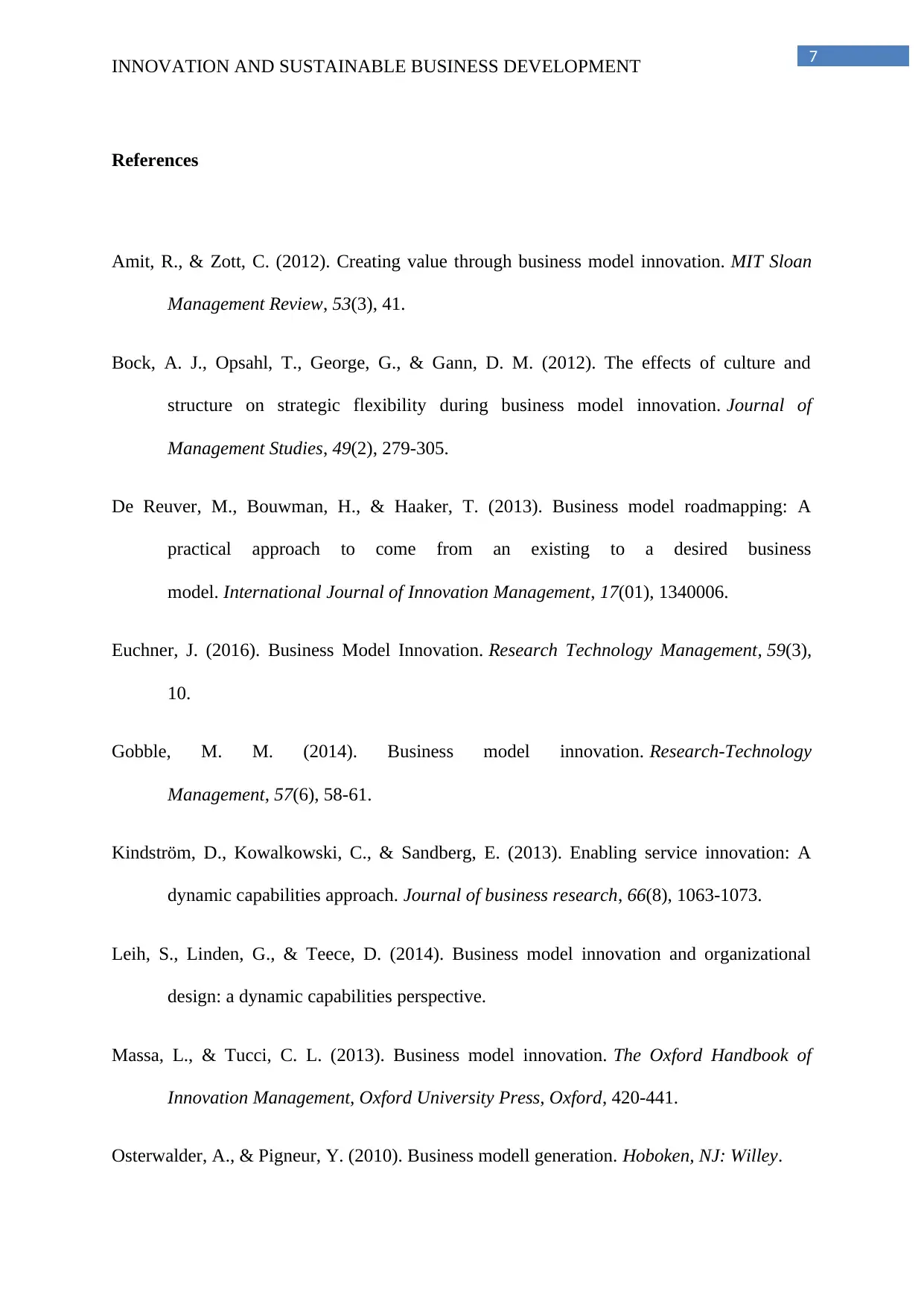
7
INNOVATION AND SUSTAINABLE BUSINESS DEVELOPMENT
References
Amit, R., & Zott, C. (2012). Creating value through business model innovation. MIT Sloan
Management Review, 53(3), 41.
Bock, A. J., Opsahl, T., George, G., & Gann, D. M. (2012). The effects of culture and
structure on strategic flexibility during business model innovation. Journal of
Management Studies, 49(2), 279-305.
De Reuver, M., Bouwman, H., & Haaker, T. (2013). Business model roadmapping: A
practical approach to come from an existing to a desired business
model. International Journal of Innovation Management, 17(01), 1340006.
Euchner, J. (2016). Business Model Innovation. Research Technology Management, 59(3),
10.
Gobble, M. M. (2014). Business model innovation. Research-Technology
Management, 57(6), 58-61.
Kindström, D., Kowalkowski, C., & Sandberg, E. (2013). Enabling service innovation: A
dynamic capabilities approach. Journal of business research, 66(8), 1063-1073.
Leih, S., Linden, G., & Teece, D. (2014). Business model innovation and organizational
design: a dynamic capabilities perspective.
Massa, L., & Tucci, C. L. (2013). Business model innovation. The Oxford Handbook of
Innovation Management, Oxford University Press, Oxford, 420-441.
Osterwalder, A., & Pigneur, Y. (2010). Business modell generation. Hoboken, NJ: Willey.
INNOVATION AND SUSTAINABLE BUSINESS DEVELOPMENT
References
Amit, R., & Zott, C. (2012). Creating value through business model innovation. MIT Sloan
Management Review, 53(3), 41.
Bock, A. J., Opsahl, T., George, G., & Gann, D. M. (2012). The effects of culture and
structure on strategic flexibility during business model innovation. Journal of
Management Studies, 49(2), 279-305.
De Reuver, M., Bouwman, H., & Haaker, T. (2013). Business model roadmapping: A
practical approach to come from an existing to a desired business
model. International Journal of Innovation Management, 17(01), 1340006.
Euchner, J. (2016). Business Model Innovation. Research Technology Management, 59(3),
10.
Gobble, M. M. (2014). Business model innovation. Research-Technology
Management, 57(6), 58-61.
Kindström, D., Kowalkowski, C., & Sandberg, E. (2013). Enabling service innovation: A
dynamic capabilities approach. Journal of business research, 66(8), 1063-1073.
Leih, S., Linden, G., & Teece, D. (2014). Business model innovation and organizational
design: a dynamic capabilities perspective.
Massa, L., & Tucci, C. L. (2013). Business model innovation. The Oxford Handbook of
Innovation Management, Oxford University Press, Oxford, 420-441.
Osterwalder, A., & Pigneur, Y. (2010). Business modell generation. Hoboken, NJ: Willey.
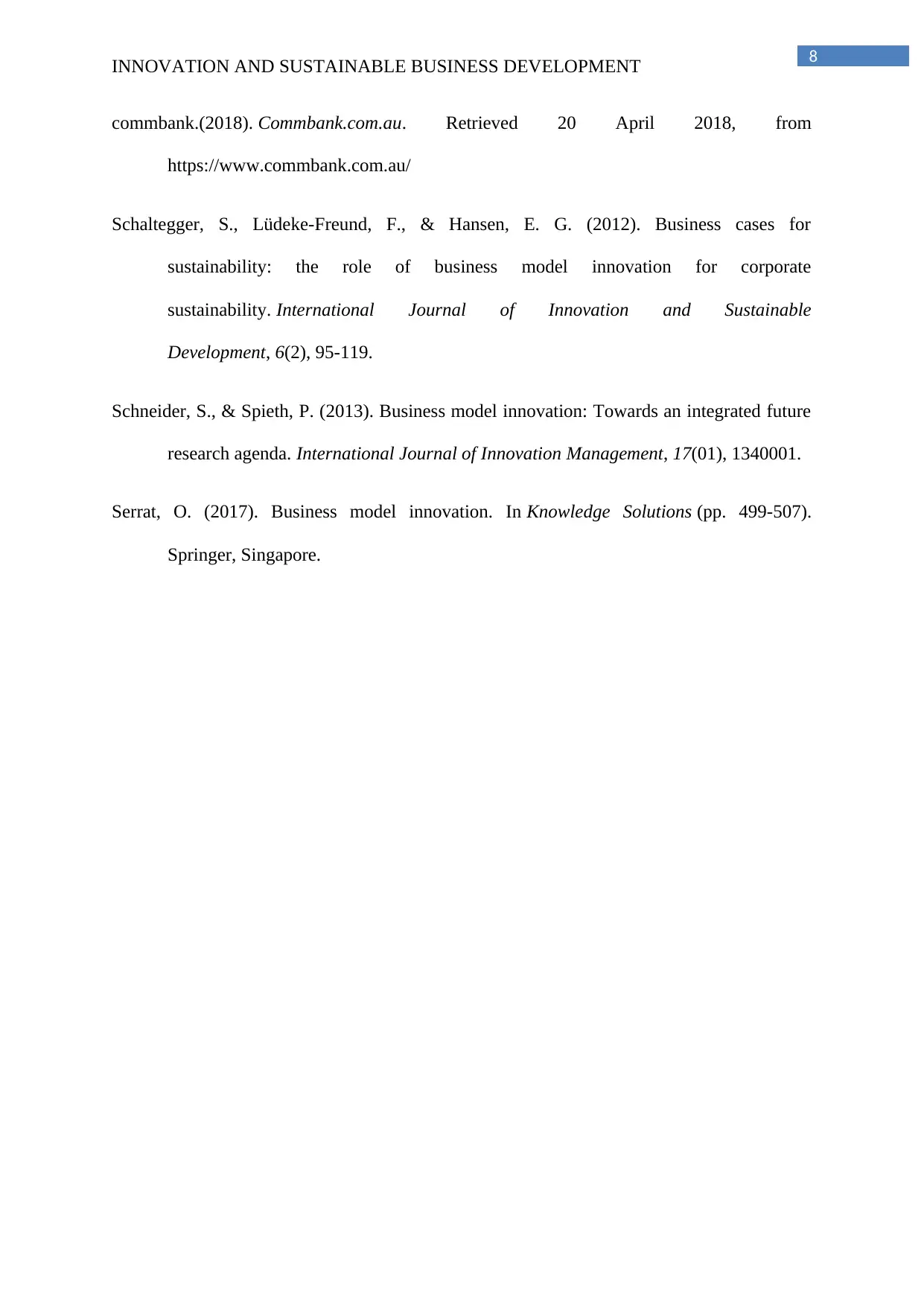
8
INNOVATION AND SUSTAINABLE BUSINESS DEVELOPMENT
commbank.(2018). Commbank.com.au. Retrieved 20 April 2018, from
https://www.commbank.com.au/
Schaltegger, S., Lüdeke-Freund, F., & Hansen, E. G. (2012). Business cases for
sustainability: the role of business model innovation for corporate
sustainability. International Journal of Innovation and Sustainable
Development, 6(2), 95-119.
Schneider, S., & Spieth, P. (2013). Business model innovation: Towards an integrated future
research agenda. International Journal of Innovation Management, 17(01), 1340001.
Serrat, O. (2017). Business model innovation. In Knowledge Solutions (pp. 499-507).
Springer, Singapore.
INNOVATION AND SUSTAINABLE BUSINESS DEVELOPMENT
commbank.(2018). Commbank.com.au. Retrieved 20 April 2018, from
https://www.commbank.com.au/
Schaltegger, S., Lüdeke-Freund, F., & Hansen, E. G. (2012). Business cases for
sustainability: the role of business model innovation for corporate
sustainability. International Journal of Innovation and Sustainable
Development, 6(2), 95-119.
Schneider, S., & Spieth, P. (2013). Business model innovation: Towards an integrated future
research agenda. International Journal of Innovation Management, 17(01), 1340001.
Serrat, O. (2017). Business model innovation. In Knowledge Solutions (pp. 499-507).
Springer, Singapore.
⊘ This is a preview!⊘
Do you want full access?
Subscribe today to unlock all pages.

Trusted by 1+ million students worldwide
1 out of 9
Related Documents
Your All-in-One AI-Powered Toolkit for Academic Success.
+13062052269
info@desklib.com
Available 24*7 on WhatsApp / Email
![[object Object]](/_next/static/media/star-bottom.7253800d.svg)
Unlock your academic potential
Copyright © 2020–2025 A2Z Services. All Rights Reserved. Developed and managed by ZUCOL.



